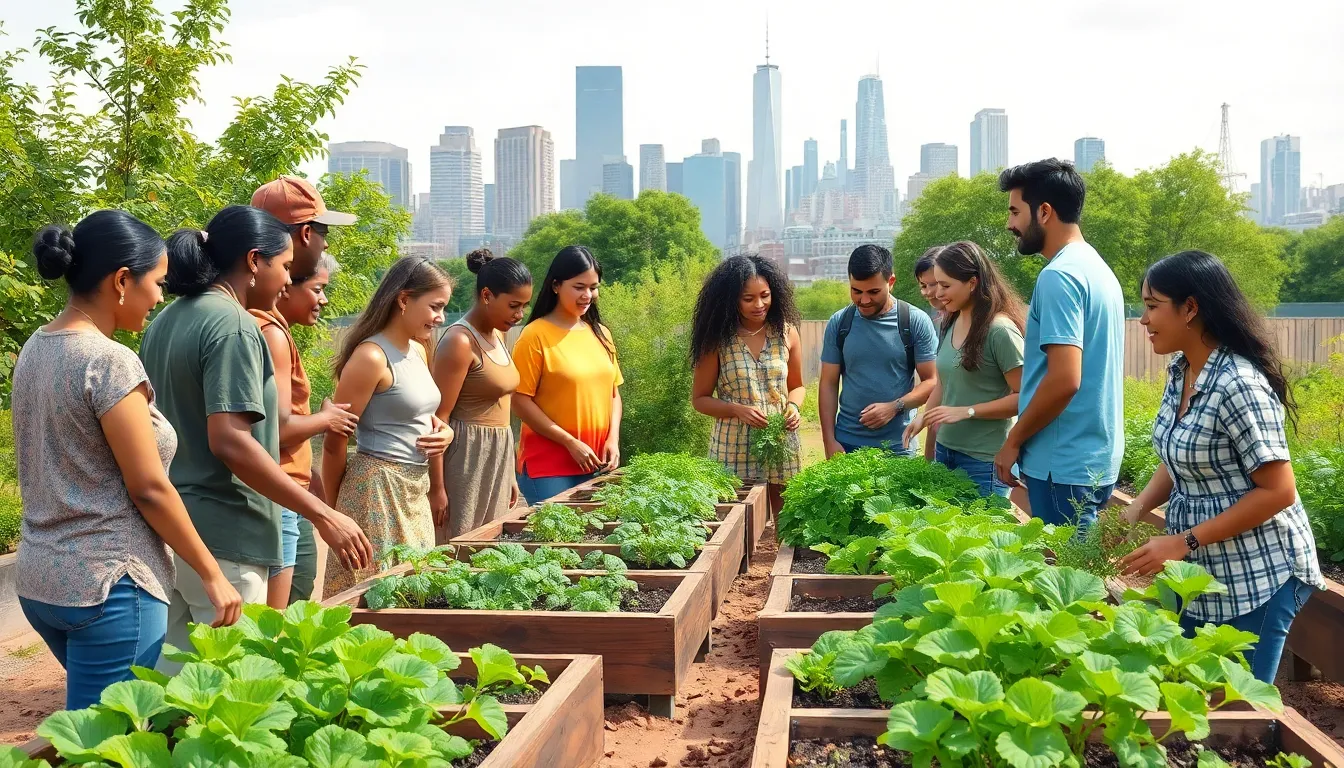As the planet heats up faster than a microwave burrito, the need for climate adaptation solutions has never been more urgent. It’s not just about saving polar bears anymore; it’s about making sure humans can still enjoy beach vacations without dodging hurricanes or wildfires. With every heatwave and flood, the stakes get higher, and the clock ticks louder.
But fear not! Innovative minds around the globe are stepping up with creative solutions that promise to turn the tide. From urban gardens sprouting on rooftops to smart water management systems that make your morning coffee possible, these adaptations are not just practical—they’re downright inspiring. Buckle up as we explore how these clever strategies can help communities thrive in a changing climate, all while keeping a smile on their faces and a sunhat on their heads.
Table of Contents
ToggleUnderstanding Climate Adaptation Solutions
Climate adaptation solutions focus on actions that help communities adjust to the impacts of climate change. These solutions become increasingly essential as natural disasters rise in frequency and intensity. Urban gardens represent one innovative approach, enhancing food security while promoting local biodiversity.
Smart water management systems also play a crucial role. By optimizing water usage and improving efficiency, these systems mitigate the effects of droughts and floods. Coastal defenses act to protect vulnerable areas from rising sea levels, preventing property damage and loss of habitat.
Community-based adaptation strategies engage local populations in the decision-making process. They encourage collaboration among residents, government agencies, and non-profits, fostering resilience. Educational programs empower individuals with knowledge on sustainable practices, ensuring long-term environmental stewardship.
Integrating green infrastructure in urban planning enhances ecological benefits. Green roofs and permeable pavements reduce urban heat islands and improve stormwater management. Renewable energy sources, such as solar and wind, contribute to energy independence while cutting greenhouse gas emissions.
Resilience hubs serve as focal points for community support during emergencies. These facilities provide resources, education, and a safe meeting space for residents in times of crisis. Each of these solutions showcases the creativity and determination needed to adapt to a changing climate successfully.
By implementing a diverse range of strategies, municipalities can create a robust framework for adaptation. This multifaceted approach enables them to respond proactively to climate challenges, ultimately improving the quality of life for their residents.
Importance of Climate Adaptation

Climate adaptation is essential as communities face increasing climate-related challenges. Effective strategies enhance resilience, protect livelihoods, and promote sustainable development.
Economic Benefits
Economic stability relies on adaptive measures that mitigate climate risks. Investments in green infrastructure yield cost savings by reducing infrastructure damage. Communities that implement water management systems experience less loss due to droughts and floods. Urban gardens boost local economies by providing fresh produce while creating job opportunities. Moreover, renewable energy initiatives drive economic growth by decreasing reliance on fossil fuels. Through adaptation, municipalities enhance their economic resilience, ensuring long-term sustainability and prosperity.
Social Resilience
Social resilience strengthens community ties and improves quality of life. Engaging residents in decision-making processes fosters a sense of ownership and responsibility. Active participation in adaptation initiatives leads to stronger social networks. Community-based strategies, such as resilience hubs, provide vital resources during emergencies, promoting collaboration. Educational programs raise awareness about climate impacts, equipping individuals with knowledge to adapt. As social bonds strengthen, communities become better equipped to face climate challenges together, enhancing their overall resilience.
Types of Climate Adaptation Solutions
Climate adaptation solutions encompass a variety of strategies aimed at helping communities adjust to climate change impacts. These solutions include infrastructure improvements and ecosystem-based approaches.
Infrastructure Improvements
Infrastructure improvements enhance resilience against climate threats. Coastal barriers protect urban areas from sea level rise, while upgraded drainage systems reduce flooding risks. Green roofs contribute to improved air quality and thermal regulation in cities. Retrofitting buildings for energy efficiency lowers energy consumption and mitigates heat effects. Creating more resilient transportation systems ensures mobility during extreme weather events. Implementing these enhancements boosts community safety and leads to long-term savings.
Ecosystem-Based Approaches
Ecosystem-based approaches utilize natural processes to adapt to climate change. Restoring wetlands enhances water quality and provides flood control benefits. Reforestation efforts increase carbon sequestration while promoting biodiversity. Creating urban green spaces improves mental well-being and offers protection from heat islands. Implementing sustainable agriculture practices safeguards food security and soil health. These approaches not only strengthen ecosystems but also foster community engagement and stewardship.
Case Studies of Successful Adaptation
Cities around the world are implementing various adaptation strategies. For example, New York City has invested in blue-green infrastructure to combat flooding and rising sea levels. This initiative focuses on creating green roofs and sustainable drainage systems. As a result, water management improves, reducing urban flooding while enhancing biodiversity.
Miami showcases another successful approach with its comprehensive sea-level rise strategy. This plan includes elevated roadways and improved stormwater systems. By prioritizing resilience in urban design, communities increase their ability to cope with climate change effects.
In the Pacific Islands, the island nation of Tonga employs community-based adaptation to enhance food security. Local initiatives encourage the establishment of climate-resilient crops. These efforts promote biodiversity and sustainability, directly benefiting local farmers and their communities.
The Netherlands stands out for its innovative flood defense systems. By incorporating nature-based solutions like restoring wetlands, they significantly reduce flood risks. This approach demonstrates a collaborative relationship between urban development and environmental preservation.
California has turned to integrated water management as an adaptation solution. This strategy enables communities to optimize water usage during droughts and floods. Successful implementation has led to enhanced agricultural resilience and sustainable practices.
Finally, coastal communities in Bangladesh implement mangrove restoration projects. By revitalizing these natural barriers, they protect shorelines from storm surges while preserving vital ecosystems. These initiatives underscore how strategic action can promote both environmental health and community resilience.
Each case study illustrates the importance of tailored adaptation solutions. Diverse approaches highlight the creativity and resourcefulness of communities facing climate challenges.
Challenges in Implementing Adaptation Solutions
Implementing climate adaptation solutions faces multiple challenges that hinder progress. Funding often presents a significant obstacle, as limited financial resources restrict the development and execution of key projects. Data collection also proves difficult, with insufficient climate data affecting the ability to plan effectively for future risks.
Community engagement may lack effectiveness, as some residents may resist change or not fully understand the proposed strategies. Communication breakdowns can exacerbate this issue, leaving community members uninformed about the benefits of adaptation efforts. People’s perception of climate urgency fluctuates, impacting their willingness to support necessary initiatives.
Technical barriers can complicate implementation, as cities may not have the expertise to develop sustainable infrastructure. Regulations may be outdated, failing to accommodate innovative solutions needed for modern challenges. Political factors often play a role, as policy shifts can disrupt ongoing projects or limit future funding.
Coordination among stakeholders remains crucial yet can be challenging. Various entities, including government agencies, NGOs, and private sectors, may not align in their goals, leading to confusion and delays. Competing interests can further impede collaboration, resulting in fragmented efforts that dilute overall effectiveness.
Finally, measuring the success of adaptation solutions tends to be difficult. Without clear metrics, evaluating progress becomes challenging, making it harder to justify ongoing investment. Addressing these challenges requires a comprehensive approach that prioritizes collaboration, communication, and commitment to sustainable adaptation practices.
The path to effective climate adaptation is paved with innovative solutions and community engagement. By embracing a variety of strategies such as urban gardens and smart water management, communities can enhance resilience and foster sustainable development.
Investment in infrastructure and ecosystem-based approaches not only mitigates risks but also promotes economic growth and social cohesion. While challenges remain in funding and implementation, the determination and creativity of communities around the world serve as a powerful reminder of what’s possible.
As efforts continue to evolve, the collective commitment to climate adaptation will be crucial in safeguarding livelihoods and ensuring a sustainable future for generations to come.


